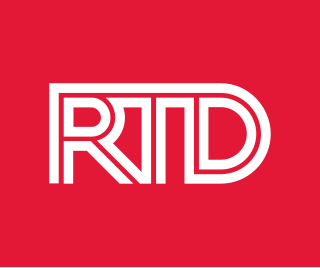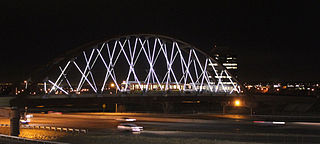
Denver Union Station is the main railway station and central transportation hub in Denver, Colorado. It is located at 17th and Wynkoop Streets in the present-day LoDo district and includes the historic station house, a modern open-air train shed, a 22-gate underground bus station, and light rail station. A station was first opened on the site on June 1, 1881, but burned down in 1894. The current structure was erected in two stages, with an enlarged central portion completed in 1914.

The Regional Transportation District, more commonly referred to as RTD, is the regional agency operating public transit services in eight out of the twelve counties in the Denver-Aurora-Boulder Combined Statistical Area in the U.S. state of Colorado. It operates over a 2,342-square-mile (6,070 km2) area, serving 3.08 million people. RTD was organized in 1969 and is governed by a 15-member, publicly elected Board of Directors. Directors are elected to a four-year term and represent a specific district of about 180,000 constituents.

The R Line or Aurora Line/I-225 Rail is a Regional Transportation District (RTD) light rail line that serves stations in Aurora, Denver, Greenwood Village, Centennial and Lone Tree. Opening on February 24, 2017, the line was designated as the “R” line, reflecting the letter R’s in “Aurora” and “Ridgegate”.

Front Range Passenger Rail is a proposed inter-city passenger train service along the Front Range and broader I-25 corridors in Colorado and Wyoming. Most proposals envision a route from Pueblo north to Colorado Springs, Denver, Boulder, Fort Collins, and usually Cheyenne. Extensions south to Trinidad, Albuquerque, and even El Paso have been discussed.

RTD Bus and Rail is a transit system in the Denver, Colorado, metropolitan area. Operated by the Regional Transportation District (RTD), it currently runs 86 local, 23 regional, 14 limited, and 3 skyRide bus routes plus some special services. It also includes 6 light rail lines and an additional 4 commuter rail lines with 78 stations and 113.1 miles (182.0 km) of track.

The Transportation Expansion (T-REX) Project was a $1.67 billion project aimed at improving transportation options for commuters in the Denver metro area within the areas of Interstate 25 and 225, which was recognized as the 14th busiest intersection in the United States at the time. The T-REX effort widened major interstates to up to 7 lanes wide in each direction and added 19 miles (31 km) of double-track light rail throughout the metropolitan area. The T-REX project finished 3.2% under its $1.67 billion budget and 22 months ahead of schedule in 2006.

Colorado's transportation consists of a network of highway, surface street, rail, and air options. While the public transportation system in Denver is much more complex and developed than other parts of the state, tourism and growth have led to extensive needs statewide.

The W Line, also called the West Rail Line, is a light rail line in Denver, Lakewood, and Golden, Colorado, United States. The W Line was the first part of FasTracks to break ground, on May 16, 2007. The line, the only line to traverse the West Corridor, opened for service on Friday, April 26, 2013.

The A Line is a Regional Transportation District (RTD) commuter rail line serving Denver and Aurora, Colorado, operating between downtown Denver and Denver International Airport (DIA). During planning and construction, it was also known as the East Rail Line, but most locals refer to it as the A Line. Despite its former title, the line does not serve the campuses of the University of Colorado.

The B Line, also known as the Northwest Rail Line during construction, is a commuter rail line which is part of the commuter and light rail system operated by the Regional Transportation District in the Denver metropolitan area in Colorado. Part of the FasTracks project, the first 6.2-mile (10 km) section from downtown Denver to south Westminster opened on July 25, 2016. If fully built out, estimated around 2042, the B Line will be a 41-mile (66 km) high-capacity route from Denver Union Station to Longmont, passing through North Denver, Adams County, Westminster, Broomfield, Louisville and Boulder.

Eagle P3 is a public–private partnership (P3) involving the Regional Transportation District (RTD) of Denver, Colorado and Denver Transit Partners, a partnership of several private companies. Under the Eagle P3 signed in 2010, Denver Transit Partners holds a 34-year contract to design, build, finance, operate and maintain RTD commuter rail lines.

The G Line, also known as the Gold Line during construction, is a Regional Transportation District (RTD) electric commuter rail line between Denver Union Station and Wheat Ridge, Colorado. Long scheduled to open in October 2016, the opening was delayed until mid-2019. The reason specified for the delay was timing issues experienced by the other commuter rail lines in the RTD system, which currently require a Federal Railroad Administration waiver to operate their grade crossings manually, and the wireless crossing system used by those lines.

Federal Center is an at-grade light rail station on the W Line of the RTD Rail system. It is located near the intersection of West 2nd Place and Routt Street, on the grounds of the Denver Federal Center, after which the station is named, in Lakewood, Colorado.

Decatur–Federal is an at-grade light rail station on the W Line of the RTD Rail system. It is located alongside the banks of the Lakewood Gulch between its intersections with Decatur Street and Federal Boulevard, after which the station is named, in Denver, Colorado. The station is located in the Sun Valley neighborhood, near the point where Lakewood Gulch meets the South Platte River. It is one of two light rail stops that serve Empower Field at Mile High, the home stadium of the Denver Broncos. The stop is adjacent to Rude Park.

The N Line, also known as the North Metro Rail Line during construction, is a commuter rail line which is part of the commuter and light rail system owned by the Regional Transportation District (RTD) in the Denver metropolitan area in Colorado. The first 13 miles (21 km) from downtown Denver to 124th Avenue in Thornton opened as part of the FasTracks expansion plan on September 21, 2020. When fully built out the line will be 18.5 miles (29.8 km) long and pass through Denver, Commerce City, Northglenn, and Thornton. The N Line features Colorado's longest bridge at 9,533 feet called the Skyway Bridge. While other RTD commuter lines are operated by Denver Transit Partners for RTD, this is the only line operated by RTD itself.

Flatiron Flyer is an 18-mile (29 km) express bus system between Denver, Aurora, and Boulder, Colorado, traveling along U.S. Route 36. Different levels of service are available, including a non-stop from Boulder to Union Station in high-occupancy toll lanes, and all-stop, which serves six park-and-rides along U.S. Route 36 in normal highway lanes. The line branches out to different destinations in Denver, Aurora and Boulder. The Regional Transportation District operates the line, opened on January 3, 2016.

Denver Airport is a commuter rail station on the A Line in Denver, Colorado, serving Denver International Airport. The A Line begins at the airport and travels west to Union Station in Downtown Denver in about 27 minutes via six intermediate stops. Trains run about every 15 minutes.

61st & Peña station is a Regional Transportation District (RTD) commuter rail station on the A Line in Denver, Colorado. The station, accessible from Tower Road is located along Peña Boulevard, the sixth eastbound station from Union Station in Downtown Denver and first westbound from Denver Airport. It is about 28 minutes from Union Station and nine minutes from Denver Airport. 61st Avenue provides access from Tower Road to the station.

Fitzsimons station is a Regional Transportation District (RTD) light rail station on the R Line in Aurora, Colorado. The station is located along the north side of Fitzsimons Parkway along Sand Creek Park and serves the University of Colorado Anschutz Medical Campus via a free shuttle bus.


















